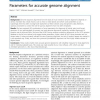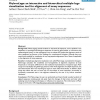97 search results - page 12 / 20 » An evolutionary progressive multiple sequence alignment |
104
click to vote
CORR
2007
Springer
15 years 9 days ago
2007
Springer
Abstract—Phylogenetic networks are a generalization of phylogenetic trees that allow for the representation of non-treelike evolutionary events, like recombination, hybridization...
112
Voted
BMCBI
2010
15 years 14 days ago
2010
Background: Genome sequence alignments form the basis of much research. Genome alignment depends on various mundane but critical choices, such as how to mask repeats and which sco...
BMCBI
2007
15 years 14 days ago
2007
Background: When aligning several hundreds or thousands of sequences, such as epidemic virus sequences or homologous/orthologous sequences of some big gene families, to reconstruc...
108
click to vote
BMCBI
2006
15 years 12 days ago
2006
Background: Several entropy-based methods have been developed for scoring sequence conservation in protein multiple sequence alignments. High scoring amino acid positions may corr...
113
click to vote
RECOMB
2003
Springer
16 years 20 days ago
2003
Springer
Protein sequence alignments are more reliable the shorter the evolutionary distance. Here, we align distantly related proteins using many closely spaced intermediate sequences as ...


